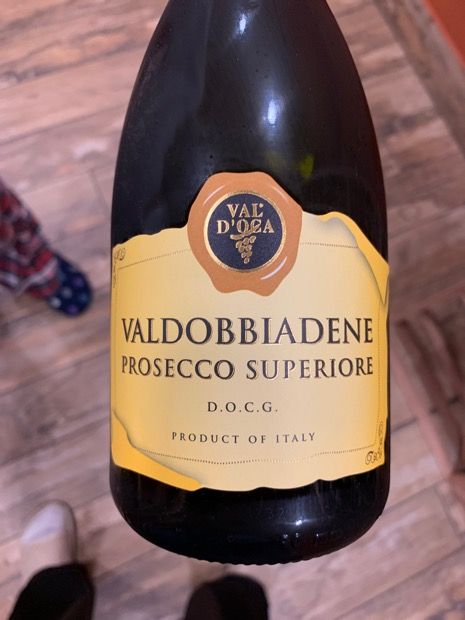
External search
Google (images)
Wine Advocate
Wine Spectator
Burghound
Wine-Searcher
Vintages
2022
2021
2020
2019
2018
2017
2016
2015
N.V.
From this producer
Show all wines
All tasting notes
|
| Drinking Windows and Values |
| Drinking window: Drink between 2020 and 2021 (based on 1 user opinion) |
| Community Tasting History |
| Community Tasting Notes (average 90 pts. and median of 90 pts. in 1 note) - hiding notes with no text | | | Tasted by isaacjamesbaker on 12/1/2019 & rated 90 points: Pale lemon color. Steely and bright on the nose, with a burst of lemon/lime, kiwi, and an exciting streak of minerals, chalk and dried flowers and herbs. Lovely creamy depth on the palate, but bright acidity keeps it lively and crisp, delightful balance. Ginger, honey, crushed chalk, white flowers, all of this on top of kiwi, lemon and green apple. This is a really impressive Prosecco that surprised me. (431 views) |
| Cantina Produttori di Valdobbiadene Producer websiteGlera Glera Grape
Glera is a white variety of grape of Slovenian origin, which was brought to village Prosecco (Slovene, Prosek) from Slovenian Kras. Glera was, until 2009, mostly referred to as Prosecco (Slovene, Prosekar).
Glera is a rather neutral grape variety which is mainly cultivated for use in sparkling Italian wine styles, frizzante or spumante, from the various Prosecco DOCG and DOC areas, although still wines also exist.
It is grown mainly in the Veneto region of Italy, traditionally in an area near Conegliano and Valdobbiadene, in the hills north of Treviso.Italy Italian Wines (ItalianMade.com, The Italian Trade Commission) | Italian Wine Guide on the WineDoctorVeneto Credit to WineCountry.it for this article
History and Tradition
The first human settlements of the lagoon and the surrounding areas maintained a simple social structure until the arrival of the Romans in the second century B.C. who divided the land into parcels of about 4,800 square meters and distributed those tracts among the locals to be cultivated.
The Romans founded the cities of Verona, Vicenza, and Padova, and named what was then the 10th imperial region, Venetia. Both the Veneto region and the province of Venice (Venezia in Italian) derive their names from the original Latin name of the area. The precursor of the city of Venice that we know today was founded during the Middle Ages when the locals escaped the barbaric invasions that followed the decline of the Roman Empire by taking refuge in coastal areas, islands, and the lagoon’s marshland.
The Venetian trade routes that connected Europe with Asia brought great wealth and general prosperity to the region. In many provinces, especially around Treviso, mulberry cultivation and the breeding of silkworms imported from China brought more affluence and prestige to local residents. With money pouring in from all quarters, Venice began its great building projects, chief among them creating the lagoon and canal infrastructure and systems still enjoyed and used today.
Between the end of the 19th century and the beginning of the 20th centuries following the opening of the Suez Canal, Venice once again became an important port city. Foreign investment financed the creation of the industrial infrastructure of Porto Marghera and freed the port of Venice from the burden of commercial navigation. Improved communications technology has allowed the rest of Italy and the world beyond closer ties to Venice, and has contributed to making Venice into an incomparable tourist destination.
The long period of power and splendor that blessed Venice encouraged the highest quality creations by local artisans. The ongoing request for jewelry, precious fabrics, lace, glass, wood and ceramic products by the noble Venetians shaped the development of typical stores along the narrow calli (streets) of Venice as well as factories both inland and on the lagoon islands. Up to today, popular tourist destinations are the Murano and Burano islands, famed for their glasswork and needlepoint products.
The Wines
Veneto is among the foremost wine-producing regions, both for quality and quantity. The region counts over 20 DOC zones and a variety of sub-categories, many of its wines, both dry and Spumanti, are internationally known and appreciated.
The three most well known DOCs are Bardolino, from the town with the same name and surrounding the shores of Garda Lake, Valpolicella, and Soave. Other noteworthy wines produced here are the white Bianco di Custoza, the excellent sparkling Prosecco, the Breganze, and the Amarone (a rich and powerful red from the Verona province). If you travel to the Treviso area, look for the little-known Clinton, a wine that is banned from distribution because it does not conform to the DOC standards, but is produced in limited quantities for local consumption.
The importance of winemaking in this region is underscored by the creation in 1885 of the very first Italian school for vine growing and oenology. In addition, Veneto was the first region to constitute the first strada del vino or "wine road". This first wine-touring road featured special road signs providing information on vines and the wines they were made into and joined the Valdobbiadene and Conegliano DOC zones crossing a series of hilly vineyards.
The most appreciated wines in the region come from the provinces of Treviso, Verona, Padova, Venice, and Vicenza. The area around Verona, with its temperate climate and hilly surrounding, is believed to have cultivated grapes since the Bronze Age. |
|




